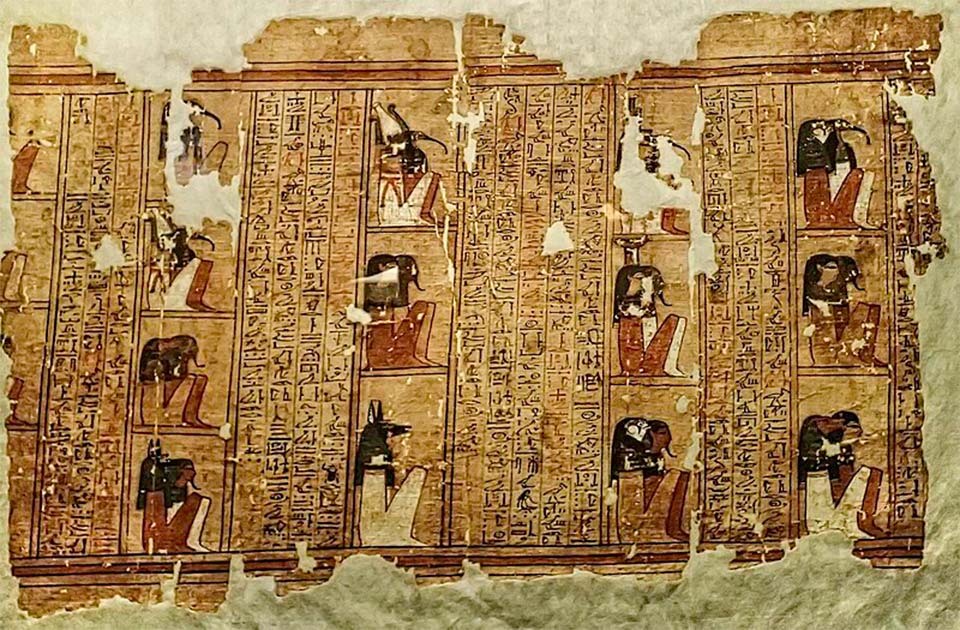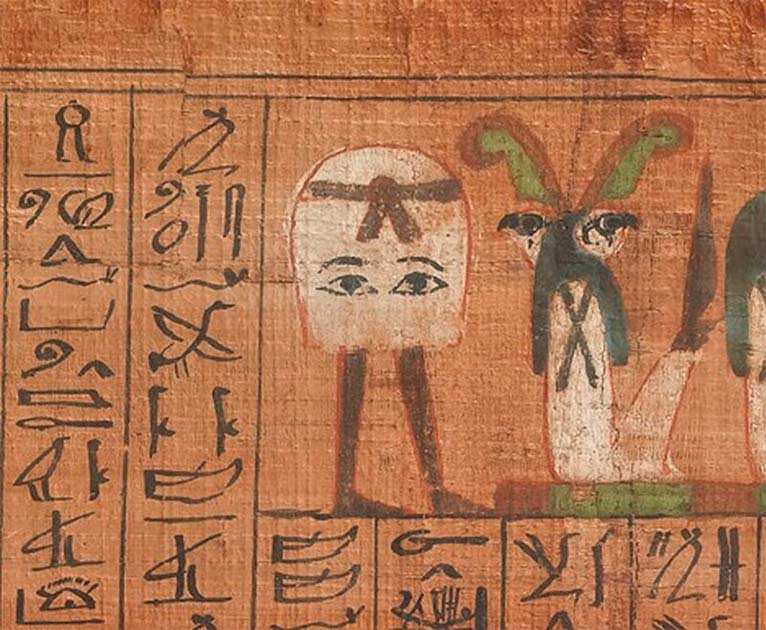Some of the most recognizable depictions of religious figures come from the hieroglyphics of ancient Egypt. The gods were worshiped and played a pivotal role in Egyptian religion for millennia.
These gods ruled over the living, the dead, nature, fate, and intangible concepts like infinity. There are over 1,500 gods that are known by name, and the pantheon appears in all aspects of civilization in ancient Egypt. There are hundreds of other minor deities; what we know about them or how they were depicted is very limited.
One of these gods was Medjed the Smiter, and with this deity the Egyptians faced a unique problem. This was a being who is present but invisible, and all that we really know about him comes from one single text.
How could Egyptians depict a god whose entire schtick was that you can’t see him? Somehow the image of this unseen god also managed to captivate Japan, and we will get on to that, but who was Medjed the Smiter, and what (if you’ll forgive us) did he look like?
Medjed the Smiter
Medjed the Smiter is an obscure minor Ancient Egyptian god that scholars in the 2010s recently rediscovered. Medjed is only mentioned in one text, The Book of the Dead.

The Book of the Dead is a funerary text from ancient Egypt written on papyrus that was used from the start of the New Kingdom (around 1550 BC) to roughly 50 BC It is made of many different papyri and contains magical spells to help a dead person through the underworld, also known as the Duat.
That’s it for Medjed. He is not mentioned again in any Ancient Egyptian religious texts, and his depictions are extremely rare in pictoral form. Medjed the Smiter (a tautology, as Medjed itself means “The Smiter”) is only in Spell 17 from the Book of the Dead, which states, “I know the name of that Smiter among them, who belongs to the House of Osiris, who shoots with his eye, yet is unseen.”
Sir Ernst Alfred Thompson Wallis Budge, a British Egyptologist who worked for the British Museum in the mid to late 1800s, translated a similar passage of text from the New Kingdom Papyri known as The Theban Recension of the Book of the Dead about Madjed the Smiter. “I know the being Mātchet [Medjed] who is among them in the House of Osiris, shooting rays of light from [his] eye, but who himself is unseen. He goeth round about heaven robed in the flame of his mouth, commanding Hāpi, but remaining himself unseen.” For anyone unfamiliar with the ancient Egyptian pantheon, Hāpi is the god of the annual flooding of the Nile. He is a popular god and is often referred to as “Lord of the Fish and Birds and Marsh” or “Lord of the River Bringing Vegetation.”
From that information alone, there is no connection between Hāpi and Medjed the Smiter. Hāpi is seen as a god bringing nutrients to the banks of the Nile river, which made the ground fertile. Medjed the Smiter is assumed to be a god of punishment for both mortals and the gods, but if there is a connection it remains obscure.
So What Does Medjed the Smiter Look Like?
The world has been able to identify images of the many Egyptian gods from hieroglyphics. We know that Anubis, the protector of the dead, is depicted as a jackal-headed man or a jackal.
The creator god Khepre is depicted as a scarab beetle or a man with a scarab beetle head. Horus, the god of the sky, is a hawk or a man’s body with the head of a hawk. These gods have been described in detail and are found all over ancient Egyptian texts, but how do you depict a god who is “unseen”?

Medjed the Smiter, only depicted twice in what is called the Greenfield Papyrus, appears as a figure with a “conical covering that reveals a pair of human eyes and two human feet.” More simply, Medjed the Smiter looks like an old-fashioned ghost Halloween costume made from a sheet with holes cut out for the eyes.
It is assumed that he is wearing a covering cloth to make him visible since he is unseen or invisible. Besides the rather adorable look of a god of punishment, Medjed the Smiter is the only Egyptian god to be depicted facing the front.
All Egyptian deities are always depicted from a side profile view, yet Medjed differs from all other gods. It is unknown why Medjed is forward-facing, and it only adds more mystery to who he was as a part of the Egyptian pantheon.
So, what can we piece together? In The Book of the Dead, Medjed the Smiter is said to be a member of the House of the god Osiris the lord of the underworld. However, the exact role he plays in the journey of the deceased through the underworld to the final judgment by Anubis (the weighting of the heart) is unknown.
His name means “Smiter,” and he can shoot “eye beams,” which do the smiting. Yet if a person’s heart is heavier than a feather it is rejected, and the goddess Ammit, the devourer of the dead, is the one to consume the heart trapping a person in the underworld.
Medjed the Smiter does not appear in this process. Perhaps his job was tied to the moment of death itself, as “smiting” after all usually leaves a body on the floor. Could this be the god who triggered your final journey to the underworld?
If this is the case, it might be possible to reinterpret his uniquely outward-facing depiction. Is Medjed looking at us as a kind of Egyptian memento mori? Is he saying “you, too, shall one day receive my gaze and die”?
Big In Japan
Medjed the Smiter is a social media sensation in Japan. Yes, this obscure sheet-wearing god of destruction is big in Japan.
- Animal Gods: The Ancient Egyptian and Hindu Pantheons
- Ugallu: Lion Headed God-Monster of Babylonian Life Insurance
In 2012, the British Museum held an exhibit of the Greenfield Papyrus at the Mori Art Museum in Tokyo and the Fukuoka Museum of Art. Once visitors saw Medjed the Smiter in his two appearances in the Greenfield Papyrus, they began to notice how he had a manga-like appearance.
Medjed looked like a famous manga character Obake no Q-Taro. Obake no Q-Taro looks like a little cartoon ghost who can’t shapeshift (Obake are shapeshifting creatures from Japanese folklore).
The people who saw the exhibit thought Medjed the Smiter was cute and looked like a silly ghost, and he blew up on Twitter. Not long after he appeared on Twitter, massive amounts of fan art were made of Medjed the Smiter.

By the following year, 2013, Medjed the Smiter became a meme. Memes spread rapidly across the internet, and they can take on a life of their own. That is what happened to Medjed the Smiter.
By 2013 Medjed the Smiter could fly and eat human hearts. He was seen as the ferocious guardian of Osiris but looked cute and silly. Some people have called Medjed the Smiter the “oldest yuru-chara” (a regional mascot). There are thousands of fan art images and cartoons of Medjed drawn by some creative artists, and his facial expression often depicts emotion or shows him with laser beams blasting from his eyes.
The Medjed the Smiter madness doesn’t stop there. Two Japanese Twitter accounts have been created and are followed by thousands of Twitter users. Digital marketplaces for homemade goods/ independent artist-created merchandise like Suzuri and Redbubble sell everything from mugs to cell phone cases and even stickers with Medjed the Smiter on them.
Medjed the Smiter has become a character in video games as well. You can find him in the Shin Megami Tensei: Persona video game series (Persona 5) and the massively multiplayer online role-playing game (MMORPG) Aura Kingdom. In the mobile app Sorato u Medjed-niisan (Big Brother Flying Medjed), players help Medjed the Smiter fly through a pyramid and navigate different obstacles.
In Japan, dating games are trendy, and Medjed the Smiter became a character in the incredibly popular game Ejikoi! In this game, the player controls a high school girl “looking for romance with one of her classmates, who all happen to be Egyptian deities.” Medjed the Smiter is one of the potential “boyfriends” for the game’s character.
In 2016 Medjed the Smiter was the star of an anime tv show. The show, Kamigami no Ki (Chronicles of the Gods) is set in 3,000 B.C in Egypt and focuses on Medjed the Smiter and other gods from the Egyptian pantheon. It seems this most obscure of Egyptian gods has risen again.
Top Image: Medjed the Smiter in the Greenfield Papyrus. Source: Unknown Author / Public Domain.